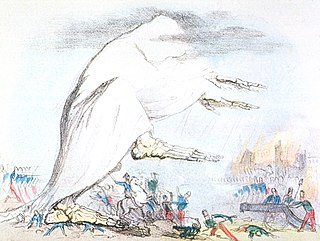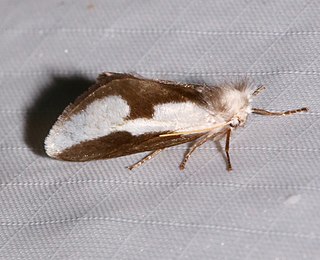
The miasma theory is an abandoned medical theory that held that diseases—such as cholera, chlamydia, or the Black Death—were caused by a miasma, a noxious form of "bad air", also known as night air. The theory held that epidemics were caused by miasma, emanating from rotting organic matter. Though miasma theory is typically associated with the spread of contagious diseases, some academics in the early nineteenth century suggested that the theory extended to other conditions as well, e.g. one could become obese by inhaling the odor of food.

Norape is a genus of moths in the family Megalopygidae. The genus was erected by Francis Walker in 1855.
Norape albilineata is a moth of the family Megalopygidae. It was described by Walter Hopp in 1927. It is found in Brazil.
Norape acuta is a moth of the family Megalopygidae. It was described by Walter Hopp in 1927. It is found in Costa Rica.
Norape capreolata is a moth of the family Megalopygidae. It was described by Walter Hopp in 1927. It is found in Colombia.
Norape draudti is a moth of the family Megalopygidae. It was described by Walter Hopp in 1927. It is found in Mexico.
Norape miasmoides is a moth of the family Megalopygidae. It was described by Walter Hopp in 1927. It is found in Brazil.
Norape truncata is a moth of the family Megalopygidae. It was described by Walter Hopp in 1927. It is found in Venezuela, Peru and Colombia.
Norape variabilis is a moth of the family Megalopygidae. It was described by Walter Hopp in 1927. It is found in Brazil.
Norape zikaniana is a moth of the family Megalopygidae. It was described by Walter Hopp in 1927. It is found in Brazil.
Norape damana is a moth of the family Megalopygidae. It was described by Walter Hopp in 1930. It is found in Brazil.
Norape dyarensis is a moth of the family Megalopygidae. It was described by Walter Hopp in 1929.
Norape plumosa is a moth of the Megalopygidae family. It was described by Arthur Gardiner Butler in 1877. It is found in Costa Rica, Panama and the Amazon region.

Norape virgo is a moth of the Megalopygidae family. It was described by Arthur Gardiner Butler in 1877. It is found from southern Texas and southern Arizona to Colombia.
Norape argyrorrhoea is a moth of the Megalopygidae family. It was described by Jacob Hübner in 1825. It is found in Argentina, Trinidad, Brazil, Guyana, Venezuela, Paraguay, Panama, Costa Rica and Mexico.
Norape incolorata is a moth of the family Megalopygidae. It was described by E. Dukinfield Jones in 1921.
Norape puella is a moth of the Megalopygidae family. It was described by Francis Walker in 1855.

Norape tener, the mesquite stinger moth, is a species of moth in the family Megalopygidae. It was described by Herbert Druce in 1897. It is found in Mexico and the south-western US.
Norape vesta is a moth of the Megalopygidae family. It was described by William Schaus in 1892.
Norape xantholopha is a moth of the Megalopygidae family. It was described by Harrison Gray Dyar Jr. in 1914. It is found in Panama, Guatemala, Colombia and Peru.



